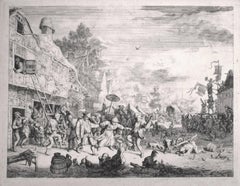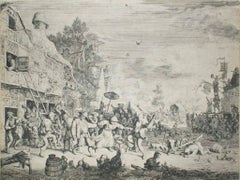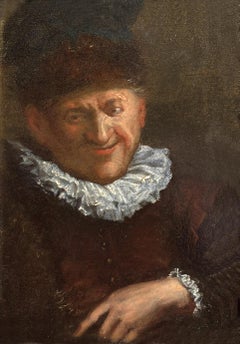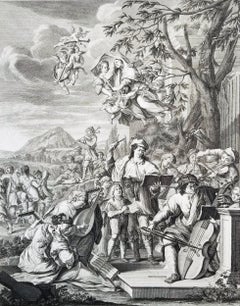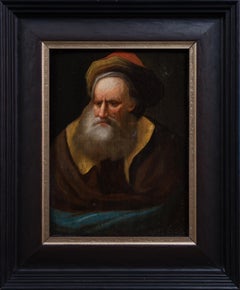Cornelis Dusart Art
Dutch, 1660-1704
Cornelis Dusart was a Dutch genre painter, draftsman and printmaker. He was born in Haarlem. Dusart was a pupil of Adriaen van Ostade from about 1675–79 and was accepted into the Haarlem Guild of St. Luke in 1679. His works are similar in style and subject to those of his mentor.
to
2
1
Overall Width
to
Overall Height
to
3
3
2
1
3
3
2
2
1
1
2
1
1
1
3
10,083
2,775
1,380
1,375
1
2
1
Artist: Cornelis Dusart
The Large Village Fair
By Cornelis Dusart
Located in Chicago, IL
The Large Village Fair, 1685
Etching
268 x 377 mm.; 10 1/2 x 13 1/4 inches
Watermark:
Arms of Amsterdam
Provenance:
H. Freiherr von und zu Aufsess (Lugt 2749)
M. Menge (Lugt 1893a).
References:
Hollstein 16
Notes:
A fine, early impression (before spots on the sky) of one of Dusart’s most powerful and fanciful works.
Concerning the provenances of this etching:
Hans von und zu Aufsess (1801-1872) was a great book lover and also a major collector of Old Master prints. He was one of the founders, in 1852, of the Germanisches Museum in Nürnberg and was that museum’s director until 1862. Mas Menge (died in 1945) was a famous violinist and also a major collector of Old Master prints and drawings.
Category
17th Century Old Masters Cornelis Dusart Art
Materials
Etching
The Kermesse - Original Etching by Cornelis Dusart - 1686
By Cornelis Dusart
Located in Roma, IT
Signed and dated on the left lower margin of the plate: “Corn. Dusart fe. 1685”. On Netherlandish watermarked paper. Very good conditions.
Bartsch n.16. Beautiful etching describes a scene of ordinary peasant’s life.
Passepartout included : 47.5 x 56 cm
Cornelis Dusart (Haarlem, 1660 - 1704), Netherlandish painter and engraver, apprentice of Adriaen van Ostade, he was accepted by the Corporation of Saint Luca...
Category
17th Century Old Masters Cornelis Dusart Art
Materials
Etching
Portrait of a Man, 17th Century Dutch Oil on Panel Portrait
By Cornelis Dusart
Located in London, GB
Circle of Cornelis Dusart
Dutch 1660 - 1704
Portrait of a Man
Oil on panel
Image size: 7¾ x 5¼ inches
Giltwood frame
Cornelis Dusart
Cornelis ...
Category
17th Century Old Masters Cornelis Dusart Art
Materials
Oil, Panel
Related Items
Vespera; Der Abend (Evening; The Evening) /// Johann Daniel Preissler Old Master
Located in Saint Augustine, FL
Artist: (after) Johann Daniel Preissler (German, 1666-1737)
Title: "Vespera; Der Abend (Evening; The Evening)"
Portfolio: Die Vier Tageszeiten (The Four Times of Day)
Year: 1723
Medium: Original Etching and Engraving on laid paper
Limited edition: Unknown
Printer: likely Johann Balthasar Probst, Augsburg, Germany
Publisher: Jeremias Wolff (Erben), Augsburg, Germany
Reference: Le Blanc No. 255, 38; Nagler No. 23
Sheet size: 22.5" x 16.63"
Image size: 17.38" x 13.63"
Condition: Soft handling creases and folds to sheet. Some scattered foxmarks in left margin. Two small tears skillfully repaired from verso in margins. Has been professionally stored away for decades. It is otherwise a strong impression in good condition with full margins
Extremely rare
Notes:
Provenance: private collection - Aspen, CO. Engraved by German artist Johann Balthasar Probst (1673-1750) after a drawing by German artist Johann Daniel Preissler (1666-1737). Comes from Preissler's 1723 "Die Vier Tageszeiten (The Four Times of Day)" portfolio of four etchings and engravings. Printed from one copper plate in one color: black. Descriptions of the portrayed image are printed in Latin and German.
Biography:
Johann Daniel Preissler, or Preisler (1666–1737) was a German painter and director of Nuremberg's Academy of Fine Arts. He was a notable member of a German artistic family, originating in Bohemia. His children included Johann Justin Preissler (1698–1771), Georg Martin Preisler (1700–1754), Barbara Helena Preisler (1707–1758; married to Oeding), Johan Martin Preisler (1715–1794), and Valentin Daniel Preisler (1717–1765), all in their time renowned artists. Most notable for his portraits, nudes and history paintings, Johann Daniel Preissler also produced drawings and frescoes. He was particularly known beyond his native Nuremberg for his "Die durch Theorie erfundene Practic", a sequence of works on art theory – the individual works were translated into several other languages and served as textbooks for students such as the Swiss Salomon Gessner...
Category
1720s Old Masters Cornelis Dusart Art
Materials
Laid Paper, Engraving, Etching
$900
H 22.5 in W 16.63 in
Portrait of an Old Bearded Man
Located in Stockholm, SE
We are pleased to offer a captivating portrait, most likely painted in the late 18th century, attributed to an artist within the circle of Christian Wilhelm Ernst Dietrich. This oil ...
Category
Late 18th Century Old Masters Cornelis Dusart Art
Materials
Oil, Wood Panel
Meridies; Der Mittag (Noon; The Midday) /// Johann Daniel Preissler Old Master
Located in Saint Augustine, FL
Artist: (after) Johann Daniel Preissler (German, 1666-1737)
Title: "Meridies; Der Mittag (Noon; The Midday)"
Portfolio: Die Vier Tageszeiten (The Four Times of Day)
Year: 1723
Medium: Original Etching and Engraving on laid paper
Limited edition: Unknown
Printer: likely Johann Balthasar Probst, Augsburg, Germany
Publisher: Jeremias Wolff (Erben), Augsburg, Germany
Reference: Le Blanc No. 255, 38; Nagler No. 23
Sheet size: 22.5" x 16.32"
Image size: 18.13" x 14.32"
Condition: Soft handling creases and folds to sheet. A few light areas of staining and scattered small areas of discoloration in margins. Two small tears skillfully repaired from verso in margins. Has been professionally stored away for decades. It is otherwise a strong impression in good condition with full margins
Extremely rare
Notes:
Provenance: private collection - Aspen, CO. Engraved by German artist Johann Balthasar Probst (1673-1750) after a drawing by German artist Johann Daniel Preissler (1666-1737). Comes from Preissler's 1723 "Die Vier Tageszeiten (The Four Times of Day)" portfolio of four etchings and engravings. Printed from one copper plate in one color: black. Descriptions of the portrayed image are printed in Latin and German.
Biography:
Johann Daniel Preissler, or Preisler (1666–1737) was a German painter and director of Nuremberg's Academy of Fine Arts. He was a notable member of a German artistic family, originating in Bohemia. His children included Johann Justin Preissler (1698–1771), Georg Martin Preisler (1700–1754), Barbara Helena Preisler (1707–1758; married to Oeding), Johan Martin Preisler (1715–1794), and Valentin Daniel Preisler (1717–1765), all in their time renowned artists. Most notable for his portraits, nudes and history paintings, Johann Daniel Preissler also produced drawings and frescoes. He was particularly known beyond his native Nuremberg for his "Die durch Theorie erfundene Practic", a sequence of works on art theory – the individual works were translated into several other languages and served as textbooks for students such as the Swiss Salomon Gessner...
Category
1720s Old Masters Cornelis Dusart Art
Materials
Laid Paper, Engraving, Etching
$900
H 22.5 in W 16.32 in
The Crucifixion (Christ on the Cross) /// Jesus after Albrecht Dürer Old Masters
Located in Saint Augustine, FL
Artist: Lambrecht Hopfer (German, Active c. 1525-1550)
Title: "The Crucifixion (Christ on the Cross)"
Portfolio: (after) The Engraved Passion
*Issued unsigned, though monogram signed by Hopfer in the plate (printed signature) lower right
Circa: 1530 (second state of three, published c. 1690)
Medium: Original Etching on laid paper
Limited edition: Unknown
Printer: The Hopfer family, Augsburg, Germany; (David Funck, Nuremberg, Germany)
Publisher: The Hopfer family, Augsburg, Germany; (David Funck, Nuremberg, Germany)
Reference: Bartsch No. VIII.527.12; Hollstein No. 12.II
Framing: Recently framed, the sheet is floated over, and top-matted with a 100% cotton fabric rag mat from Holland in a wood moulding and Museum glass
Framed size: 14.88" x 13.88"
Sheet size: 5.5" x 3.63"
Condition: Trimmed to platemark. A few tiny professional repairs: at elbow of Jesus's right arm and the inside thigh of Jesus. Some light skinning upper right corner and lower right area. It is otherwise a strong impression in good condition
Very rare
Notes:
Provenance: private collection - Green Bay, WI; acquired from Sotheby's, New York, NY in c. 2015. The artist Lambrecht Hopfer's printed monogram signature "LH" lower right. The printer/publisher David Funck's (plate) number "182" lower right. This etching is after Albrecht Dürer’s 1511 engraving "The Crucifixion (Christ on the Cross)", ("Dürer-Katalog" - Meder No. 13, page 73). Printed in black from an iron plate. The image depicts Christ on the cross at center, the Virgin at left, two Maries behind her, St. John standing at right, a Roman solider behind him. It is after the eleventh plate of Dürer's sixteen plates from his 1507-1513 "The Engraved Passion" series, ("Dürer-Katalog" - Meder No. 3-18, page 70-74).
"The print was originally designed without the number engraved in the lower margin (First state: Lambrecht Hopfer, c. 1530). The Hopfers' descendant David Funck (Nuremberg, 1642–1705) acquired over two hundred of their original iron plates, engraved numbers into them, and re-printed them around 1686-1700. The "182" indicates that "The Crucifixion" was the 182nd print in Funck’s series (Second state: David Funck, c. 1686-1700). About a century later, 92 of these plates were acquired by Carl Wilhelm Silberberg in Frankfurt and printed for the third and final time in the book "Opera Hopferiana", of which "The Crucifixion" was the 90th print (Third state: Carl Wilhelm Silberberg for "Opera Hopferiana", 1802)". - Elizabeth Upper, Cambridge University Library, University of Cambridge, Cambridge, UK
Biography:
Lambrecht (Lambert) Hopfer (Active c. 1525-1550) was a German Old Masters printmaker. He was the brother of Hieronymus Hopfer (Active c. 1520-1530) and son of Daniel Hopfer...
Category
16th Century Old Masters Cornelis Dusart Art
Materials
Etching, Laid Paper
Portrait of an Old Bearded Man With a Black Cap
Located in Stockholm, SE
We are pleased to offer a captivating portrait, most likely painted in the late 18th century, attributed to an artist within the circle of Christian Wilhelm Ernst Dietrich. This oil ...
Category
Late 18th Century Old Masters Cornelis Dusart Art
Materials
Oil, Wood Panel
Angelic Cherubs with Classical Figure in Wilderness Finely Painted Preparatory
Located in Cirencester, Gloucestershire
Figure with Cherubim in Wilderness
Italian School, 17th century
oil painting on wood panel
framed 13 x 11 inches
condition: overall for its age very good, though the work is most likely a preparatory...
Category
17th Century Old Masters Cornelis Dusart Art
Materials
Oil, Wood Panel
$3,553
H 13 in W 11 in D 1 in
Italian 18th Century Oval Religious Oil on Canvas Painting with Saint Dominic
By Francesco de Mura
Located in Firenze, IT
This beautiful Italian 18th Century old masters oil painting on oval canvas with giltwood frame is attributed to Solimena and features a religious scene.
In this splendid oval-shaped painting are depicted Saint Dominic...
Category
18th Century Old Masters Cornelis Dusart Art
Materials
Canvas, Oil
$13,150
H 21.66 in Dm 15.75 in
Aurora sive Tempus Matutinum; Der Wohl und Übel angewandte Morgen /// Old Master
Located in Saint Augustine, FL
Artist: (after) Johann Daniel Preissler (German, 1666-1737)
Title: "Aurora sive Tempus Matutinum; Der Wohl und Übel angewandte Morgen (Dawn or Morning Time; The Morning Used for Better or For Worse)"
Portfolio: Die Vier Tageszeiten (The Four Times of Day)
Year: 1723
Medium: Original Etching and Engraving on laid paper
Limited edition: Unknown
Printer: likely Johann Balthasar Probst, Augsburg, Germany
Publisher: Jeremias Wolff (Erben), Augsburg, Germany
Reference: Le Blanc No. 255, 38; Nagler No. 23
Sheet size: 22.57" x 16.38"
Image size: 17.75" x 14"
Condition: Soft handling creases, folds, and scattered faint areas of discoloration to sheet. Three tears skillfully repaired from verso. Has been professionally stored away for decades. It is otherwise a strong impression in good condition with full margins
Extremely rare
Notes:
Provenance: private collection - Aspen, CO. Engraved by German artist Johann Balthasar Probst (1673-1750) after a drawing by German artist Johann Daniel Preissler (1666-1737). Comes from Preissler's 1723 "Die Vier Tageszeiten (The Four Times of Day)" portfolio of four etchings and engravings. Printed from one copper plate in one color: black. Descriptions of the portrayed image are printed in Latin and German.
Biography:
Johann Daniel Preissler, or Preisler (1666–1737) was a German painter and director of Nuremberg's Academy of Fine Arts. He was a notable member of a German artistic family, originating in Bohemia. His children included Johann Justin Preissler (1698–1771), Georg Martin Preisler (1700–1754), Barbara Helena Preisler (1707–1758; married to Oeding), Johan Martin Preisler (1715–1794), and Valentin Daniel Preisler (1717–1765), all in their time renowned artists. Most notable for his portraits, nudes and history paintings, Johann Daniel Preissler also produced drawings and frescoes. He was particularly known beyond his native Nuremberg for his "Die durch Theorie erfundene Practic", a sequence of works on art theory – the individual works were translated into several other languages and served as textbooks for students such as the Swiss Salomon Gessner...
Category
1720s Old Masters Cornelis Dusart Art
Materials
Laid Paper, Engraving, Etching
$900
H 22.57 in W 16.38 in
Erasmus of Rotterdam
By English School
Located in GB
Hans Holbein the Younger (1497/98 – 1543) was one of the greatest painters of the Northern Renaissance. Born in Augsburg, Germany, he was the son of Hans Holbein the Elder, also a pa...
Category
19th Century Old Masters Cornelis Dusart Art
Materials
Oil, Wood Panel
Two royal portraits (the Duc d'Angoulême and the Duc de Berry) by H.P. Danloux
Located in PARIS, FR
These two royal portraits are a major historical testimony to the stay of the Comte d'Artois (the future Charles X) and his family in Edinburgh in 1796-1797. Given by the sitters to Lord Adam Gordon, the Governor of Edinburgh, and kept by family descent to this day, these two portraits provide us with a vivid and spontaneous image of the Duc d’Angoulême and his brother the Duc de Berry. Danloux, who had emigrated to London a few years before, demonstrate his full assimilation of the art of British portrait painters in the brilliant execution of these portraits.
1. Henri-Pierre Danloux, a portraitist in the revolutionary turmoil
Born in Paris in 1753, Henri-Pierre Danloux was first a pupil of the painter Nicolas-Bernard Lépicié (1735 - 1784) and then, in 1773, of Joseph-Marie Vien (1716 - 1809), whom he followed to Rome when, at the end of 1775, Vien became Director of the Académie de France. In Rome he became friends with the painter Jacques-Louis David (1748 - 1825).
Returning to France around 1782, he settled in Lyon for a few years before returning to Paris in 1785. One of his first portraits was commissioned by the Baroness d'Etigny, the widow of the former Intendant of the Provinces of Gascony, Bearn and Navarre Antoine Mégret d'Etigny (1719 – 1767). He then became close to his two sons, Mégret de Sérilly and Mégret d'Etigny, who in turn became his patrons. In 1787, this close relationship with the d'Etigny family was further strengthened by his marriage to Antoinette de Saint-Redan, a relative of Madame d'Etigny. After his marriage, he left for Rome and did not return to France until 1789. It was during the winter of 1790-1791 that he painted one of his masterpieces, the portrait of Baron de Besenval. Set in a twilight atmosphere, this portrait of an aristocrat who knows that his death is imminent symbolizes the disappearance of an erudite and refined society which would be swept away by the French Revolution.
The Jacobin excesses led Danloux to emigrate to England in 1792; many members of his family-in-law who remained in France were guillotined on 10 May 1794. Danloux enjoyed great success as a portrait painter in England before returning to France in 1801.
During his stay in England, Danloux was deeply under the influence of English portraitists: his colors became warmer (as shown by the portrait of the Duc d'Angoulême that we are presenting), and his execution broader.
2. Description of the two portraits and biographical details of the sitters
The Duc d'Angoulême (1775-1844) was the eldest son of the Comte d'Artois, the younger brother of King Louis XVI (the future King Charles X), and his wife Marie-Thérèse of Savoie. He is shown here, in the freshness of his youth, wearing the uniform of colonel-general of the "Angoulême-Dragons" regiment.
He is wearing the blue cordon of the Order of the Holy Spirit, which was awarded to him in 1787, and two decorations: the Cross of Saint-Louis and the Maltese Cross, as he was also Grand Prior of the Order of Malta.
Born on 16 August 1775 in Versailles, Louis-Antoine d'Artois followed his parents into emigration on 16 July 1789. In 1792, he joined the émigrés’ army led by the Prince de Condé. After his stay in Edinburgh (which will be further discussed), he went to the court of the future King Louis XVIII, who was in exile at the time, and in 1799 married his first cousin Marie-Thérèse Charlotte of France, the daughter of Louis XVI and the sole survivor of the royal family. The couple had no descendants. He became Dauphin of France in 1824, upon the accession to the throne of his father but played only a minor political role, preferring his military position as Grand Admiral. Enlisted in Spain on the side of Ferdinand VII, he returned home crowned with glory after his victory at Trocadero in 1823.
He reigned for a very short time at the abdication of Charles X in 1830, before relinquishing his rights in favor of his nephew Henri d'Artois, the Duc de Bordeaux. He then followed his father into exile and died on 3 June 1844 in Gorizia (now in Italy).
His younger brother, the Duc de Berry, is shown in the uniform of the noble cavalry of the émigrés’ Army. He is wearing the blue cordon of the Order of the Holy Spirit, awarded to him in May 1789, and the Cross of Saint-Louis (partly hidden by his blue cordon).
Born on 24 January 1778 in Versailles, Charles-Ferdinand d'Artois also followed his parents into emigration and joined the émigrés’ army in 1792. After his stay in Edinburgh, he remained in Great Britain, where he had an affair with Amy Brown...
Category
1790s Old Masters Cornelis Dusart Art
Materials
Canvas, Oil, Wood Panel
Hadrian's Mausoleum, Castel S. Angelo: A Framed 18th Century Etching by Piranesi
By Giovanni Battista Piranesi
Located in Alamo, CA
This large framed 18th century etching by Giovanni Battista Piranesi entitled "Veduta del Mausoleo d'Elio Adriana ora chiamato Castello S. Angelo nella parte opposta alla Facciata de...
Category
1750s Old Masters Cornelis Dusart Art
Materials
Etching
$4,700 Sale Price
20% Off
H 28.88 in W 37.25 in D 1.25 in
The Roman Colosseum: A Framed 18th Century Etching of the Interior by Piranesi
By Giovanni Battista Piranesi
Located in Alamo, CA
This large framed 18th century etching by Giovanni Battista Piranesi entitled "Veduta dell'interno dell'Anfiteatro Flavio detto il Colosseo" (View of the interior of the Flavian Amph...
Category
1760s Old Masters Cornelis Dusart Art
Materials
Etching
$4,700 Sale Price
20% Off
H 28.88 in W 37.25 in D 1.25 in
Cornelis Dusart art for sale on 1stDibs.
Find a wide variety of authentic Cornelis Dusart available for sale on 1stDibs. You can also browse by medium to find art by Cornelis Dusart in etching, oil paint, paint and more. Much of the original work by this artist or collective was created during the 18th century and earlier and is mostly associated with the Old Masters style. Not every interior allows for large Cornelis Dusart, so small editions measuring 6 inches across are available. Customers who are interested in this artist might also find the work of Flemish School, 17th Century, Giovanni Benedetto Castiglione, and Crispin de Passe II. Cornelis Dusart prices can differ depending upon medium, time period and other attributes. On 1stDibs, the price for these items starts at $7,669 and tops out at $11,500, while the average work can sell for $9,191.
